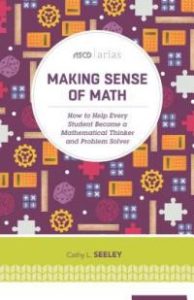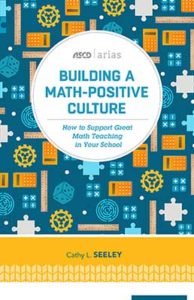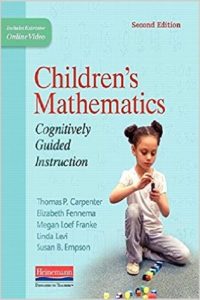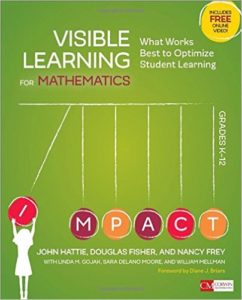The OISE Library has recently acquired a number of books related to mathematics instruction as a part of our Curriculum Resources collection. These books are highly relevant to students and faculty in our Department of Curriculum, Teacher and Learning, offering content ranging from hands-on activity suggestions, to research on understanding children and teenagers’ mathematical thinking.
Two of these new titles are books by Cathy Seeley, a math teacher of more than 30 years and former President of the National Council of Teachers of Mathematics. The companion books, Making Sense of Math: How to Help Every Student Become a Mathematical Thinker and Problem Solver and Building a Math-Positive Culture: How to Support Great Math Teaching in Your School, are both brief works which efficiently address key concepts and methods relevant to modern math teaching. The two works offer advice for fostering successful math students and teachers, detailing frameworks that are relevant to math instruction from K-12.
 Making Sense of Math is intended for teachers, offering a primer on effective methods and approaches for improving math instruction and students’ mathematical thinking. Seeley espouses the benefits of allowing students to “productively struggle”, presenting problems as an opportunity to learn from mistakes and difficulties rather than merely an exercise in finding the right answer. She urges teachers not to perceive intelligence and math ability as innate or fixed, suggesting that students can grow as they approach challenging material which builds their problem solving ability and conceptual understanding of math.
Making Sense of Math is intended for teachers, offering a primer on effective methods and approaches for improving math instruction and students’ mathematical thinking. Seeley espouses the benefits of allowing students to “productively struggle”, presenting problems as an opportunity to learn from mistakes and difficulties rather than merely an exercise in finding the right answer. She urges teachers not to perceive intelligence and math ability as innate or fixed, suggesting that students can grow as they approach challenging material which builds their problem solving ability and conceptual understanding of math.
Building a Math-Positive Culture is intended for school leaders, offering tips for implementing school or system-wide programs based on the classroom techniques and approaches detailed in Making Sense of Math. Seeley touches on many of same topics as in Making Sense of Math, but focuses more on advice relevant to school leaders hoping to design effective math programs and support mathematics teachers. Making Sense of Math and Building a Math-Positive Culture can be read and applied together or separately, while the content of the two books is highly interrelated, Seeley’s overarching ideas are clearly explained in both texts.
Seeley touches on many of same topics as in Making Sense of Math, but focuses more on advice relevant to school leaders hoping to design effective math programs and support mathematics teachers. Making Sense of Math and Building a Math-Positive Culture can be read and applied together or separately, while the content of the two books is highly interrelated, Seeley’s overarching ideas are clearly explained in both texts.
Getting students engaged and excited about mathematics can be tricky, a problem Elana Reiser aims to address in Teaching Mathematics Using Popular Culture: Strategies for Common Core Instruction from Film and Television. This is the first book by Reiser, a professor at St. Joseph’s College focusing on mathematics education, who has published articles previously on the intersection of math and popular culture. The book is aimed at high school mathematics teachers and features activities which link clips from film and television to strands in the Common Core Standards mathematics curriculum. A chapter is dedicated to each of the Common Core strands, including number and quantity, algebra, functions, modelling, geometry, and statistics and probability. The activities range from facilitating a discussion about memorizing versus understanding mathematics concepts inspired by a Modern Family clip, to graphing the clowns’ logic in Dumbo. Rather than full lesson plans, the book’s diverse activities are intended as jumping off points for teachers, offering suggestions of film and media which address relevant mathematics concepts and issues.
Children’s Mathematics: Cognitively Guided Instruction written by Thomas P. Carpenter, Elizabeth Fennema, Megan Loef Franke, Linda Levi, and Susan B. Empson, seeks to place an understanding of children’s mathematical thinking at the centre of math instruction. This updated second edition comes 15 years after the publication of the first and includes further research on children’s mathematical thinking and the effects of Cognitively Guided Instruction (CGI) in the classroom. The book focuses on teaching primary students whole-number arithmetic, incorporating an understanding of how children conceptualize addition, subtraction, division, and multiplication. Key concepts of CGI are explained with direct quotes and workbooks from children providing insight into how they approach mathematical concepts. The second edition also features a number of video modules, which include interviews with young learners and case study examples of CGI at work in the classroom.
This updated second edition comes 15 years after the publication of the first and includes further research on children’s mathematical thinking and the effects of Cognitively Guided Instruction (CGI) in the classroom. The book focuses on teaching primary students whole-number arithmetic, incorporating an understanding of how children conceptualize addition, subtraction, division, and multiplication. Key concepts of CGI are explained with direct quotes and workbooks from children providing insight into how they approach mathematical concepts. The second edition also features a number of video modules, which include interviews with young learners and case study examples of CGI at work in the classroom.
Visible Learning for Mathematics: What Works Best to Optimize Student Learning by John Hattie, Douglas Fisher, and Nancy Frey, with Linda M. Gojak, Sara Delano Moore, and William Mellman, applies the visible learning framework developed by Hattie directly to mathematics instruction. Hattie has previous published Visible Learning and Visible Learning for Teachers, both books and now Visible Learning for Mathematics draw on a database of educational studies created by Hattie and his research team, the database includes 70,000+ studies which in turn allows them to perform 1200+ meta-analyses. The results of these meta-analyses form the basis of Hattie’s books on visible learning, using the data to both highlight best practices and reveal ineffective ones. The book applies Hattie’s three phases of learning surface, deep, and transfer to mathematics instruction from K-12, offering an explanation of the evidence which supports these phases and how student learning can be supported. Additionally, the book includes a series of videos featuring classroom teachers further illustrating the concepts discussed by Hattie and his co-authors.
Hattie has previous published Visible Learning and Visible Learning for Teachers, both books and now Visible Learning for Mathematics draw on a database of educational studies created by Hattie and his research team, the database includes 70,000+ studies which in turn allows them to perform 1200+ meta-analyses. The results of these meta-analyses form the basis of Hattie’s books on visible learning, using the data to both highlight best practices and reveal ineffective ones. The book applies Hattie’s three phases of learning surface, deep, and transfer to mathematics instruction from K-12, offering an explanation of the evidence which supports these phases and how student learning can be supported. Additionally, the book includes a series of videos featuring classroom teachers further illustrating the concepts discussed by Hattie and his co-authors.
All the book featured in this post are available on the new arrivals bookshelf, next to the circulation desk.
